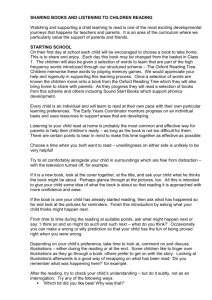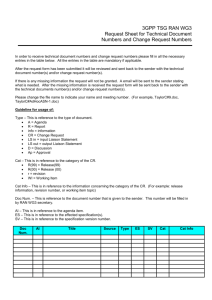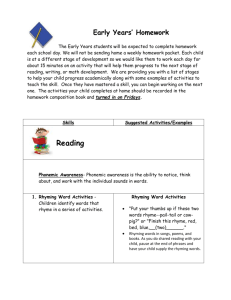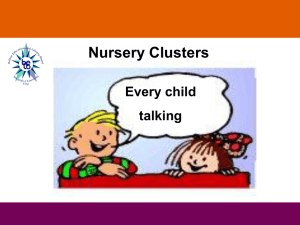Speech and Language Therapy Advice Sheets
advertisement
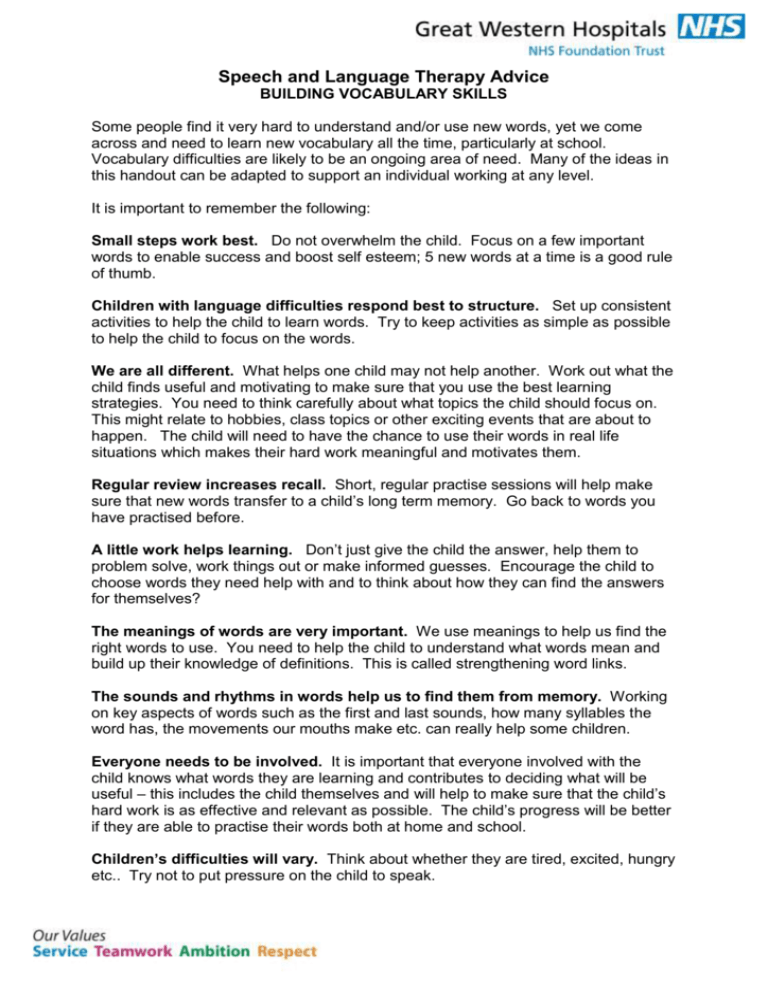
Speech and Language Therapy Advice BUILDING VOCABULARY SKILLS Some people find it very hard to understand and/or use new words, yet we come across and need to learn new vocabulary all the time, particularly at school. Vocabulary difficulties are likely to be an ongoing area of need. Many of the ideas in this handout can be adapted to support an individual working at any level. It is important to remember the following: Small steps work best. Do not overwhelm the child. Focus on a few important words to enable success and boost self esteem; 5 new words at a time is a good rule of thumb. Children with language difficulties respond best to structure. Set up consistent activities to help the child to learn words. Try to keep activities as simple as possible to help the child to focus on the words. We are all different. What helps one child may not help another. Work out what the child finds useful and motivating to make sure that you use the best learning strategies. You need to think carefully about what topics the child should focus on. This might relate to hobbies, class topics or other exciting events that are about to happen. The child will need to have the chance to use their words in real life situations which makes their hard work meaningful and motivates them. Regular review increases recall. Short, regular practise sessions will help make sure that new words transfer to a child’s long term memory. Go back to words you have practised before. A little work helps learning. Don’t just give the child the answer, help them to problem solve, work things out or make informed guesses. Encourage the child to choose words they need help with and to think about how they can find the answers for themselves? The meanings of words are very important. We use meanings to help us find the right words to use. You need to help the child to understand what words mean and build up their knowledge of definitions. This is called strengthening word links. The sounds and rhythms in words help us to find them from memory. Working on key aspects of words such as the first and last sounds, how many syllables the word has, the movements our mouths make etc. can really help some children. Everyone needs to be involved. It is important that everyone involved with the child knows what words they are learning and contributes to deciding what will be useful – this includes the child themselves and will help to make sure that the child’s hard work is as effective and relevant as possible. The child’s progress will be better if they are able to practise their words both at home and school. Children’s difficulties will vary. Think about whether they are tired, excited, hungry etc.. Try not to put pressure on the child to speak. D:\106740456.doc CREATING A VOCABULARY BOX. This is a special box in which the child keeps a set of vocabulary cards for the different words that they are learning. It is an idea that can be used at any stage, but as the child gets older they might want something more discrete, eg. a Personal Organiser that can fit into their bag. Choose 5 words and help the child to make a new card for each word that they are going to learn. Depending on the time that you have available this might take more than one day. Talk about what each word means and make sure that the child understands it. Clap the number of syllables and identify the first and last sounds. Talk about whether it is a long or short word. If possible ask the child to draw a picture of the word on the front of the card. If they have motor difficulties you might offer them a selection of pictures so that they can choose one to cut out and stick on. It is important that they have some input into making the cards. If the child is learning to use a colour coding system to help highlight the different uses of words (things, actions, descriptions etc.) ask them how they would like to show this information on the card, eg. put the correct colour dot in one corner. Write the word on the back of the card and work with the child to build up a word web to show what the word means: white winter flake s melts crunchy soft cold snow snowman snowballs It can really help some children if you create very visual/tactile images. If the child finds it useful then put the first sound and lines to represent the number of syllables under the picture on the front of the card. D:\106740456.doc Page 2 of 7 Set aside time at least once a day to look at the words, play vocabulary games and practise making up sentences with them. As the child’s vocabulary develops you can introduce a filing system for the box working from front to back: 1. 2. 3. 4. 5. 6. New/difficult words Words from last week Words from 2 weeks ago Words from 1 month ago Words from 2 months ago Words that I know. These words can gradually be removed and kept safe for revision at a later date. The number of words/sections will depend on the child and how easy/difficult they find vocabulary work. When you have looked at the new/difficult words then check some of the words from further back in the box. You can slowly move the words back through the box as the child becomes familiar with them. Remember that it is essential not to rush. If a child is having trouble learning words then think about the games and strategies that you are using and whether they are the most helpful for that child. Some children take a very long time to learn to use new words reliably and may well learn words and then forget them again. This means that it is important to review old words rather than assume that because a child used to be able to use them they will still be able to now. This system can help children to learn approximately 50 words a term. PHONOLOGICAL AWARENESSS Children with word finding difficulties often benefit from thinking about the sounds and rhythms of words. Further information is available in a separate handout or you can find useful ideas in the DfES Publication “Letters and Sounds”. The key skills that help word finding are: Hearing how many syllable or beats there are in a word Hearing the beginning and end sounds of words Hearing the different sounds within syllables or more complicated words Thinking of words which rhyme Remember, that you are thinking about the sounds, not the letters in words (eg. “sh” and “air” are both one sound. Some children are not ready to use letters and find it helpful to relate the different sounds to pictures and gestures, eg. using Jolly Phonics, or prefer to start by making patterns with coloured blocks. It is essential to check that the child has the key language skills that they need to be able to do phonics activities. As a minimum make sure that they understand the concepts – first, middle, next, last and same and different. D:\106740456.doc Page 3 of 7 VOCABULARY GAMES AND ACTIVITIES: We use the meanings of words to “file” them in our memory and then enable us to get them back out again when we need to use them. Children who have weak vocabulary skills tend to need extra time and support to build up their filing system for words. Games in which the child is encouraged to think about the different meanings and key ideas behind words are a great way to help. Name/label things during the day. Encourage the child to name things when you are out for a walk/looking at a book/on the bus/at the supermarket etc.. Sort words according to their category. To begin with you might choose simple categories, eg. animals, food, clothes. In this activity there is a clear distinction between the different groups. As the child’s skills improve then encourage them to think about more refined groupings, eg. puddings, drinks, snacks. You can think of categories for all sorts of word types, eg. Actions might be distinguished by who does them – human, animal or machine or by which part of the body you use- brain, hand, face. Ask the child to talk to you about why they are putting the pictures or words into the categories that they choose. This will help to boost their skills. Recall words within categories. Once a child is good at sorting words then you might see if they can remember words to fit into different categories. You could hold up 5 fingers and see if they can think of 5 different plant words. If they find this hard then try starting them off by naming a few things yourself. Fruit Salad. This is a group game. Each child chooses a fruit. The adult starts them off by naming 2 of the fruits. These children have to stand up and swap seats. The adult tries to sit on one of the seats, leaving one of the children with nowhere to sit. This child then moves to the middle of the circle and calls the next 2 fruits. Memory Games. Games such as “I went shopping and I bought…” require children to name and recall items in categories. The repetition involved can really help some children. If you are using the game to work on vocabulary skills make a picture list as you go round. You can then use this to support children’s recall of words. Bean Bag game. This is a group game. A beanbag is thrown to one of the children who says their name and then something within an agreed category, eg. “My name is Emma and I like eating apples.” They then choose who to throw to next. Automatic Response/Sentence Closure. See if the child can finish off familiar pairs or sentences. For example, Cup and ….. (saucer) Bats and ……. (balls). Find the item. This is a version of “I spy”. Look at a complex picture together (or use the setting you are in) and give each other clues for something that you can see. To begin with you could look for lots of things, eg. “Let’s find everything that is purple.” Give more specific skills as the child’s skills develop. Question Bingo: Give the child a set of pictures. Ask questions which match the pictures and see if the child can find the correct one and give it to you. Eg. Lay out the pictures book, car, money, tree – Ask “What has pages?” “What has leaves?” Mime. Have a set of objects or pictures and see if the child can mime one for you to guess. (This might be very hard for children with motor planning difficulties). Swap D:\106740456.doc Page 4 of 7 over and see if they can guess what you are miming. Get them to tell you why they gave the answer they did, eg. “you were pretending to peel the banana and then you ate it.” Noun- Verb. Can the child think of an action word that is usually used with a word that you say? Eg. “Spoon” – “eat.” Guess the Word. In this game you have a set of pictures/words and the child has to try and guess which one you are describing. For example: “It is an animal, it is grey, it lives in Africa or the zoo, it is very big, it has a trunk.” The child can guess at any time. If they are correct you can move on to the next picture. If they are wrong remind them of what you have already said and give them more information. This game helps children to build up their store of meanings and practise finding words from their filing system. You can use cards that you have made or commercially available games (but make sure that the vocabulary is suitable for the child’s level). To make this game harder, describe a card that the child cannot see. Take the definitions challenge. Make a simple definitions mat. This might be a strip of sections moving from left to right or a circular board with a space for the word in the middle. Work with the child to see if you can find something to say about the word for each section of the mat. Sections to include might be: Appearance: What does it look like? Feel like? Smell like? Made of? Function: What does it do/How do we use it? People: Who uses it? Time: When do we use it? Place: Where do we use it? Family: What group does it belong to? Think of something else in the family. Association: What goes with it? Reaction: How does it make you feel? You might need to change the sections depending on the skills of the child and the types of words that you are working with Alternatively you could make up a set of cards with the different questions on and see if the child can work through the pack for one of their vocabulary box words. Characteristics Game. Have characteristics/category cards in piles. Choose 2 and see if the child can name something that has both characteristics, eg. long and yellow – “banana”. Increase the number of characteristics to make it harder Twenty Questions. This is more difficult than Guess the Word. Think of an item and the child is allowed to ask you 20 questions to try and work out what you are thinking of. This helps to generalise the skills worked on in definitions challenge. Odd one out. Present 4 objects, pictures or words, can the child tell you which is the odd one out? Ask them to explain their choice. Choose words that are closer in meaning to make the game harder. Eg. orange, banana, book, apple (easy) or orange, banana, carrot, apple (hard) If you are asking the child to remember a list of items make sure that they are able to remember everything you say. Similarities and differences. Put two pictures down and see if the child can tell you something that is the same about them and then something that is different. Eg. D:\106740456.doc Page 5 of 7 Bicycle and Car – both have wheels but a car has an engine and a bike does not. Make this game harder by choosing words that are very similar in meaning. Word Associations. If you say a word can the child think of an associated word, eg. “cat” – dog, whiskers or kitten. You could play this game in a group by seeing how far around the circle you could get. Opposites. Can the child think up a word with the opposite meaning to the one that you say. Eg. “Stop” – “Go”. Auditory Association. Can the child extend their opposites skills within more defined categories, eg. “Mountains are high, valleys are………….(low). A man may be a king, a woman may be ………..(a queen) Words with the same/similar meanings (Synonyms). Give the child a word and see how many words they can think of which have the same or a very similar meaning. Eg. BIG – huge, large, enormous. Talk about the different words and how you might use them. Multiple Meanings (Homonyms). Talk about words that can have more than one meaning, eg. bank, trunk, wave. Can the child make up a sentence for each meaning? Looking at jokes together can be a fun way to explore this area. Silly Sentences. Make up a sentence and ask the child if it makes sense. Can they tell you what is wrong? What could you have said? Eg. “John swam through the mud to the other side of the river.” (water). Crosswords. These can be a fun way to practise thinking of words from definitions. Rhyming “I-Spy”. Give the child a rhyme clue. Eg. “I spy something that sounds like hair.” Chair. First sound lists. Pick a letter and see if the child can think of things from a set of categories for this letter, eg. “b”, a fruit: “banana”, transport “bus”, job: “builder.” Give the child clues if they cannot think of something by themselves. Turn taking alphabet games. The child has to use the alphabet sequence within their answer. Eg. The Ministers Cat - “The Ministers cat is an angry cat”, “The Ministers cat is a beautiful cat” Alternatively the adult selects a category and then you take turns to think of items, eg. Animals – ant, bee, cat etc. This is much harder than simple category games. First and Last Sound chaining. You have to think of a word beginning with the last sound of the word that someone else said, eg. “cup – paint – teapot – tiger – rabbit – toe – elephant”. This can be made even more difficult by restricting words to a single category e.g. countries If you introduce a time element to these games it will make them more difficult. A child’s performance will be affected by internal and external factors such as noise, stress, being tired or ill. D:\106740456.doc Page 6 of 7 LEARNING TO BE A WORD DETECTIVE. Vocabulary difficulties are likely to be a long term problem. It is important to help children to develop skills that will allow them to extend their vocabulary independently. One way to do this is to help the child to learn to use the information within a sentence to work out the meaning of words that they do not know. This is particularly important for children who read fluently, but with limited understanding of the text. Encourage the child to tell you if they come across a word that they do not understand. Instead of simply telling them the meaning, see if they can guess what it means as you use the word in a sentence or short story. Make sure that you use as many familiar words as you can and try to choose something that will make the meaning as clear as possible. Using words that allow the child to create a visual picture in their mind is often helpful. For example: “Plughole” – The lady went to the sink and poured the water out of the jug. She watched the water going down the plughole and listened to the glug glug noise it made as it disappeared.” You can use strategies such as acting or writing the sentence down to support the child. Children might find it very hard to develop this skill to begin with. Explain that you are helping them to learn to work out words for themselves and give them gentle support to boost their chance of success. This skill is something that it can be fun to work on in group sessions. Identify a list of words that you want the children to learn. Write sentences to look at together. Work through the sentences as a group, thinking about the clues as you go. What information have you worked out? What does the group think that the word means? D:\106740456.doc Page 7 of 7
